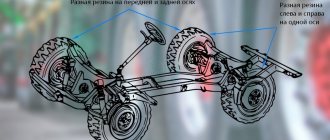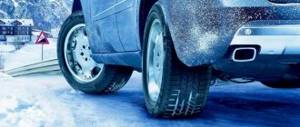It is recommended to focus on plus 7 degrees, which will remain stable for some time. However, there are nuances, because spring never comes overnight.
Winter tires are not at all designed for operation at temperatures exceeding +7 degrees, and manufacturers openly declare this and do not guarantee their reliability. Enough tests have been carried out on this topic, both by manufacturers and car owners.
But you shouldn’t change to summer tires if:
- Frosts still occur at night;
- It’s not uncommon to travel out of town where the roads are poorly cleared;
- there is snow or ice on the road;
- The machine is operated mainly very early in the morning and/or late in the day, when there is a possibility of icy roads.
Negative consequences of using winter tires in summer:
- Extended braking distance
- Insufficient controllability
- Accelerated wear of winter tires
- Earlier onset of aquaplaning
- High noise level
- Increased fuel consumption
(Later in the article we will analyze each point in detail)
!!! – Remember that tires are not only spare parts. parts and consumables of your car are for the safety of you and your passengers.
Summer tire catalog
Selection of tires by car
Normative base
Legal regulation in the field of installation and use of tires on vehicles in the summer is carried out by the following legislative acts:
- Technical regulations TR CU 018/2011 – regarding the timing of replacement of winter tires.
- Appendix 1 to Government Decree No. 1008 of December 5, 2011 - on what criteria tires must meet in order for the car owner to successfully pass inspection.
- Section 5 of the “List of faults and conditions under which the operation of the vehicle is prohibited”, contained in Government Decree No. 1090 of October 23, 1993, states that if the tires do not meet which parameters, the operation of the vehicle is prohibited.
- Chapter 12 of the Code of Administrative Offenses – on liability for non-compliance with the legislation on the use of tires.
When is it legally necessary to install summer tires?
In 2021, based on clause 5.5. Appendix 8 to the Technical Regulations TR CU 018/2011, you cannot drive a car with studded tires in the summer months:
- June;
- July;
- August.
It turns out that if a car owner drives on studded tires in winter, then they must be replaced (by law) before June 1, 2020. If this is not done, the law will be considered violated.
In ab. 2 clause 5.5. Appendix 8 to the Technical Regulations TR CU 018/2011 states that you cannot drive a vehicle that does not have winter tires in:
- December;
- January;
- and February.
As you can see, it is prohibited to replace studded tires with summer tires before March 1 - this would be a violation of the law.
Accordingly, you need to change winter tires with studs to summer ones on any day of spring, that is, from March 1 to May 31. Other types of winter tires (without studs) do not need to be changed by the summer, and it is completely legal to drive.
When should you change your tires to summer ones?
The official requirement to change winter tires to summer tires is legally enshrined in the Technical Regulations of the Customs Union “On the safety of wheeled vehicles. Appendix No. 8, paragraph 5.5 states that the operation of vehicles with studded tires is prohibited in the summer - June, July, August. It also stipulates that winter tires (marked with a snowflake against a mountain background or the M+S sign) are required for the winter period - December, January, February. Please note that the wording is very precise - in the summer you cannot drive on studded tires, and in the winter on those tires that do not have “winter” markings.
The earliest date when you need to change tires to summer ones in Russia is March 1, 2021. Those who decide to change their tires back in February will face trouble at the very first traffic police station. But the deadline when it’s time to change your wheels is June 1, 2021, when it will no longer be legal to have studded tires on your car. However, the law has a small caveat that it gives regional authorities the right to determine when local drivers change their shoes, and this rule only applies upward. In some regions, the period may begin in April or even March. You can usually find out when tires are officially required to be changed in your area from the local press or on the websites of road services in your city. In Moscow, the official date is March 1, but experts advise waiting until April 10.
What about Velcro tires? And there is not a word about them in the law! That is, if we take what is written to the letter, then according to the laws of the Russian Federation it is quite legal to drive in the summer on winter tires, as long as they do not have a single spike on the surface. This even applies to studded tires, in which all the studs have fallen out over time. If there are no thorns, then there are no problems, says the law.
Does it then make sense to rush to change tires to summer ones? Here it comes down to the driver’s consciousness - does he want to expose himself and others to danger by not changing winter tires to summer tires on time?
Car owners who care what tires their car drives on the roads should go to a tire shop when the thermometer rises to 5-7 °C, there will be no snow, much less ice on the roads, and this level of heat will remain at least a week. In warmer regions, you can make an appointment at a tire center as early as early spring; For residents of areas where it is much colder, it is better to wait until April, but you need to have time before the end of May.
In total, three months are given to replace winter tires, but rushing through this matter, however, will be unnecessary. It is not worth changing winter tires to summer tires in advance, when it is still cold outside, due to the properties of the tire compound for summer - it hardens too much and becomes brittle even at a temperature of 0 ° C, which leads to deterioration of the car’s grip on slippery surfaces and the appearance of cracks on the tread.
Requirements for summer tires in 2021
Requirements for summer tires in 2021 are presented in Section 5 of Appendix 8 to the Technical Regulations TR CU 018/2011:
- The vehicle must have tires recommended by the manufacturer;
- The tire size must match the wheel rim;
- according to the speed category and load-bearing capacity index, the rubber must correspond to the maximum speed of the vehicle according to the technical documentation and the permissible weight per tire (for example, the 82H marking will mean that the tire can be installed on a car with a maximum speed of up to 210 km/h and in the case if it does not bear a load of more than 475 kg);
- The tread height of summer tires must be more than 1.6 mm (for cars, trucks weighing up to 3500 kg and trailers up to 3500 kg), 2 mm for buses, 0.8 mm for motor vehicles, 1 mm for all others (trucks and trailers over 3500 kg);
- damage to tires is not allowed (various punctures, through and non-through cuts), exposing the cord, delamination of the carcass, sidewall, or sealing layer.
Requirements for seasonal tire replacement
When the winter season arrives, any car owner should put his “iron horse” on the right rubber tires. At the same time, many people have a question related to the period of “changing shoes” based on real weather conditions. The answer to it is set out in the Technical Regulations of the Customs Union (hereinafter referred to as the Technical Regulations), which have been in force in our country since 2015.
Decision of the Customs Union Commission dated 12/09/2011 N 877 (as amended on 12/25/2018) “On the adoption of the technical regulations of the Customs Union “On the safety of wheeled vehicles” (together with “TR CU 018/2011. Technical regulations of the Customs Union. On the safety of wheeled vehicles” Vehicle")
Practical understanding of the issue
For a practical understanding of the rules under consideration, it should be borne in mind that winter non-studded tires with Velcro can be used all year round. If you use summer tires in the warm months of the year, they must be replaced between September and November, and the reverse steps should be carried out with the onset of spring, namely from March to May. Different territories of Russia (based on climatic conditions) have their own periods for replacing winter tires with summer tires, for example:
- In Moscow, it is recommended to change winter tires from 15.10. until 25.10, and summer from 10.04. to 16.04.
- In the Novosibirsk region, winter from 12.10. to 17.10, and summer from 24.04 to 30.04.
- In the Perm region, winter from 12.10. to 17.10, and summer from 17.04 to 23.04.
- In the Irkutsk region, winter from 10.10. to 16.10, and summer, respectively, from 25.04 to 30.04.
What to consider when changing winter tires to summer tires
Important! The above deadlines seem to be somewhat arbitrary, and therefore it is more advisable to “change shoes” of the car a little earlier than the designated dates. This action will allow you to avoid the queue for tire fitting, and will also prevent you from suddenly getting onto an icy road on summer wheels.
Legal transition to winter tires
This year, you need to take into account the following operating conditions for seasonal tires:
- studded tires should be removed from the car before June;
- Summer tires are prohibited from being installed on a car before February.
Thus, the law allows replacing winter wheels with summer ones from March to May inclusive.
Read also: Children's rights at school
Exact timing for replacing studded wheels
If you strictly adhere to the deadlines established by the Technical Regulations, using different types of tires is allowed in the following order.
| Type of wheels and their markings | Service life |
| Summer wheels without M&S markings | From March to November inclusive |
| Winter studded tires with M&S markings | From September to May inclusive |
| Winter studless wheels with Velcro and M&S markings | Throughout the year from January to December |
Features of all-season operation
There is also a group of certain drivers who prefer all-season wheels with Velcro (designed for use throughout the year). This tire can be used in winter from December to February only if it has the following markings:
- "M+S";
- M&S;
- "MS".
Tread of all-season and winter tires
If the wheels do not have the above symbols, the use of all-season tires during the winter months is prohibited!
Requirements for installing last year's wheels
The possibility of using rubber that has actually been in use for more than one year directly depends on its wear, as well as the presence of serious damage to it. Rubber wear is determined by the remaining tread depth and should be:
- for transport category L - no more than 0.8 mm;
- for cars of categories N2, N3, O3, O4 - no more than 1 mm;
- for cars of categories M1, N1, O1, O2 - no more than 1.6 mm;
- for cars of category M2, M3 - no more than 2 mm.
Regarding external damage to the rubber, it should be noted that it should not have punctures, cuts, “hernias” and tears, as well as peeling of the tread from the side of the wheel.
Important! Failure to comply with any of the above conditions is a violation of the law.
In addition, there is a rather important nuance in the operation of machine tires, which every vehicle driver should know about. The rubber installed at the front and rear wears unevenly and differently. On the driving axle of the car, wear is more significant. In connection with the above, “used” tires should be installed so that the drive axle has less worn tires.
In practice, car owners use two methods to correctly alternate tires on axles:
- When replacing tires, you should leave the marks LP (left-front), PP (right-front), LZ (left-rear), RZ (right-rear) on the tires with a marker or chalk. In addition, you can insert appropriate notes with these notes into the tires themselves.
- The depth and extent of wear is assessed by performing a thorough visual inspection of the tires before installation. The option under consideration is the most painstaking and complex and can cause difficulties with slight wear of the rubber.
Requirements for purchasing and installing new tires
First of all, before purchasing tires, you need to study the vehicle’s operating instructions, which contain a section covering the permissible characteristics for tires.
How to choose winter tires
Secondly, it should be borne in mind that the tires (all four tires) installed on the axles of the car must be the same. The law does not prohibit the use of tires on the front axle that differ from those on the rear axle on one car, but it is more advisable to install wheels of the same size, markings and tread pattern on the car. The secret is that different modifications of tires generally contain different compositions, which sometimes has a negative effect on their coefficient of adhesion to the road surface. In this regard, the car may behave unpredictably when braking.
Advice! Ideally, you should purchase tires that are completely identical to each other in all respects (type, size, marking). It is necessary to take into account that tires of the same model, produced at different enterprises and in different years, may have a different percentage of wear, which is directly related to the handling of the car.
Driving on all-season tires in the summer season
“All-season” is tires that are designed for use at any time of the year - both winter and summer.
These types of tires are not equipped with anti-skid studs, which means that they can be legally driven in the summer (after all, in the summer months it is prohibited to drive only a vehicle with studded tires).
However, during the hot season in Russia, it is still not recommended to use all-season tires, since they are intended for countries with a mild climate - where there are no significant differences in air temperature between seasons. It’s better to go to a tire shop and install standard summer tires.
Features of using correctly selected summer tires
Every car owner should know at what temperature they change winter tires to summer tires, and what tires are suitable for your car. When choosing high-quality tires, it is worth considering the optimal size and tread pattern of seasonal tires. Reliable products will have the following important characteristics:
- Maximum level of grip on the road surface;
- Excellent directional stability of the car, thanks to the use of special hard blocks;
- Minimal noise while driving;
- Tire durability;
- Wear resistance when moving on different types of road sections;
- An excellent level of protection from the negative effects of moisture, mechanical damage and other factors.
To ensure that new tires are ideal for your vehicle, it is worth considering the season, the type of surface you will be driving on, and your driving style. If you do not want to get into emergency situations that bring trouble to you and other road users, you should approach the issue of replacing seasonal tires responsibly. If you use tires appropriate for this season in the summer, you will not only not receive a fine, but will also be able to feel more confident on the road. The use of winter studded tires is officially prohibited only in the summer months, but you should not drive on such tires in the spring, when the air temperature does not drop below +5 degrees. Taking into account the peculiarities of seasonal tire changes, you will fill every trip with comfort.
Riding on Velcro during the summer months of the year
Among motorists, “Velcro” (friction tires) are winter tires that are not equipped with studs.
In accordance with Technical Regulations TR CU 018/2011, you can drive on such tires all year round. After all, tires with studs are prohibited in summer, but Velcro does not have them. Just as you can drive in winter, because it is winter and has the appropriate markings (MS, M & S, M + S).
However, like all-season tires, Velcro tires are highly not recommended for use in the hot season, primarily due to the “softness” of the rubber compound used in their manufacture. Otherwise, the following consequences are possible:
- loss of controllability;
- increase in braking distance;
- acceleration of tire wear;
- increased fuel consumption.
Penalties for “wrong” winter tires
This year, the current administrative legislation does not contain references to the Technical Regulations.
In other words, it is impossible to fine a driver for not having winter tires on his car. However, it is possible that in the near future such a legal norm and, accordingly, a penalty will be introduced. Read also: Combining a loggia with a room
The law provides for liability for the operation of worn-out winter tires, in the form of imposing a fine of 500 rubles on the violator or warning him (which is also considered administrative liability). A similar fine is imposed on a driver whose car is on tires marked M+S, etc. In this case, the tire tread depth in the most “killed” place must be less than 4 mm and the car is operated on an icy or snowy road (route).
Driving in summer on tires equipped with studs
In clause 5.5. Appendix 8 to the Technical Regulations TR CU 018/2011 clearly states that you cannot drive a car in the summer (June, July, August) that has tires with anti-skid spikes installed.
It turns out that such tires can be used 9 months a year - all autumn, winter and spring. The deadline for motorists to remove winter studded wheels from their cars in 2020 is May 31.
However, you should not wait for the specified date. It is recommended to change tires with studs to summer tires, all-season tires or Velcro tires when the average daily temperature for several days is from plus 5 to 7 degrees Celsius and only after the icy and snow-covered surfaces have completely disappeared from the roads.
Replacing winter tires with summer tires for trucks
More recently, owners of trucks were required to change tires at the same time as owners of cars, motorcycles, buses, etc.
That is, when driving in winter on studded tires, you had to change them to summer tires before May 31 (or earlier). And if there was Velcro, you could ride it all year round without changing it at all.
But on November 11, 2018, amendments to the Technical Regulations TR CU 018/2011 came into force, which allowed owners of all categories of cars, except M1 and N1, to drive in winter on any tires at all:
- all-season;
- “Velcro”;
- summer;
- winter
It turns out that owners of trucks of categories N2 (from 3,500 to 12,000 kg) and N3 (over 12,000 kg) can simply buy summer tires and drive on them all year round without “changing shoes.” But for those who have a car of class N1 (trucks up to 3500 kg), for the winter they still need to install tires designed specifically for use on snowy or icy surfaces.
As for the summer, the ban remained unchanged for everyone - that is, if the truck owner has tires with studs, they must be removed before May 31 - driving in the summer on such tires is prohibited. It will be possible to put on studded tires again on September 1st. No. 1, No. 2 and No. all other types of tires in June, July and August without any restrictions .
Existing fines for improper use of car tires in 2020
In 2020, Chapter 12 of the Code of Administrative Offenses, which regulates the liability of motorists for violating traffic rules, does not contain any indication of sanctions for non-compliance with the requirements of the Technical Regulations TR CU 018/2011.
And since only it contains a mention of the timing of tire replacement, fines for late replacement of winter tires with summer tires in 2021 cannot currently be imposed.
And yet, traffic police officers have the opportunity to punish the driver with a monetary penalty. But only for non-compliance of tires with the requirements specified in Section 5 of the “List of Malfunctions and Conditions” to the Traffic Regulations. In this case, sanctions will apply under Part 1 of Art. 12.5. Administrative Code:
- warning;
- or a fine of 500 rubles.
For example, the above liability should be expected if the tire:
- has a tread height below the established values;
- has punctures, cuts, and delaminations of the frame;
- does not correspond to the speed index and weight of the vehicle model.
In addition, a warning or 500 rubles will be issued if different tires are installed on one axle of the vehicle (front or rear) on the left and right. For example, the front left has summer tires, and the front right has winter tires. Or one tire is new and the other is retreaded.
The traffic police will also fine you for installing both studded and non-studded tires on a vehicle at the same time (regardless of the axle). For example, 3 wheels have tires without studs, and the remaining one has them.
So it turns out that if you drive in the summer on the same studded tires, then there is no penalty. And if, for example, you put tires with studs, but of different sizes, on one axle in the hot season, then the driver will face sanctions under Part 1 of Art. 12.5. Code of Administrative Offences.
If the spare tire is different from those already installed on the vehicle
Each car has a spare tire, which will be needed in case one of the tires has been punctured and you need to get to the nearest tire shop without resorting to a tow truck.
In clause 5.7.4. Technical regulations TR CU 018/2011 say that different tires (winter and non-winter, for example) cannot be installed on the same axle. However, the requirements of this paragraph do not apply in the case of temporary installation of a spare wheel on the vehicle.
In this case, it is important whether the “spare tire” is on winter tires or summer tires (since the note to clause 5.7.4. applies only to this clause). That is, “seasonality” must correspond. For example, you cannot install a spare tire in the summer if it (theoretically) has anti-skid studs (but there will be no fine for this).
In clause 5.5. “The list of faults and conditions”, which contains a similar rule about the inadmissibility of installing different tires on one axle, there is no such note about the “spare wheel” as in the Technical Regulations TR CU 018/2011. Therefore, it remains unclear whether or not the driver will be able to be charged under Part 1 of Art. 12.5. Code of Administrative Offenses specifically for the temporary use of a spare wheel that is different in size or other characteristics from those already installed on the vehicle (for the out-of-season “spare wheel,” as we have already indicated, there are no fines).
Spare tire mismatch
Every conscientious driver has a spare tire in his car, which in the event of a traffic accident will help him get to a car service station. However, the ban on using different wheels does not apply in this situation.
Interestingly, installing a wheel with studded tires in the summer is prohibited, but if it is installed as a result of a breakdown of the main wheel, the driver will not be issued a fine.
We recommend
“Fine for driving on winter tires: how much you will have to pay” More details
Motorists should note that:
- The law does not define the period during which the spare tire can be used;
- you can come in the summer for a technical inspection on studded tires, and no one will be able to issue a fine to the driver, because the law does not say anywhere that the wheels are checked for seasonality;
- There is a draft law that provides for a fine of 2,000 rubles in case of violation of the rules and regulations for the operation of tires and wheels, but it was not adopted in 2021.
So, according to the law, the driver is required to change tires to summer tires from March 1 to June 1. However, if your vehicle has studless tires, there is no need to change them.
Nuances
Some features:
- if you come for a technical inspection on winter studded tires in the summer, then nothing will happen (since Appendix 1 to Resolution No. 1008 does not indicate that tires are checked for their compliance with the season);
- It is unclear for how long it is allowed to put a “spare” on (it seems that only for the purpose of traveling to a place of permanent parking and/or repair);
- There was still a draft law on fines for using out-of-season tires (No. 464241-6), but it was never adopted (according to it, it was proposed to add a new part 3.2 to Article 12.5, according to which motorists would be fined 2000 rubles for violating the rules for using wheels and tires).
https://prav-voditel.ru/pravila-ekspluatatsii-avtomobilya/kogda-menyat-zimnyuyu-rezinu-na-letnyuyu
How to determine that winter tires are worn out and require replacement?
It is worth changing tires not only with the onset of a new season, but also as they naturally wear out. The main indicator in this matter is the remaining tread depth. On winter tires it should not be less than 4 mm, and on summer tires this value should exceed the limit of 1.6 mm. Now many manufacturers equip their tires with special indicators. This is a convenient tool that shows the level of wear well. The indicators are located on the protector itself in the form of pictograms, logos or digital designations. Their wear means that the rubber has lost some of its performance properties and your vehicle will no longer be as maneuverable and safe on slippery sections of the road.
You can also measure the tread depth using a coin, but the results of such a test are considered to be only approximate. To obtain more accurate indicators, special electronic devices and other means (rulers, calipers, etc.) are used. Traffic police inspectors also use digital devices in their work. If an employee notices that your vehicle has tires of the wrong size, speed and load index, or the remaining tread depth is less than the permissible value, he may impose a fine of 500 rubles.
Inspecting your tires daily is a good habit for self-respecting drivers. If you notice punctures, cuts or other damage, contact a tire shop immediately and do not wait until you lose control on the road or face fines for using improper tires.










